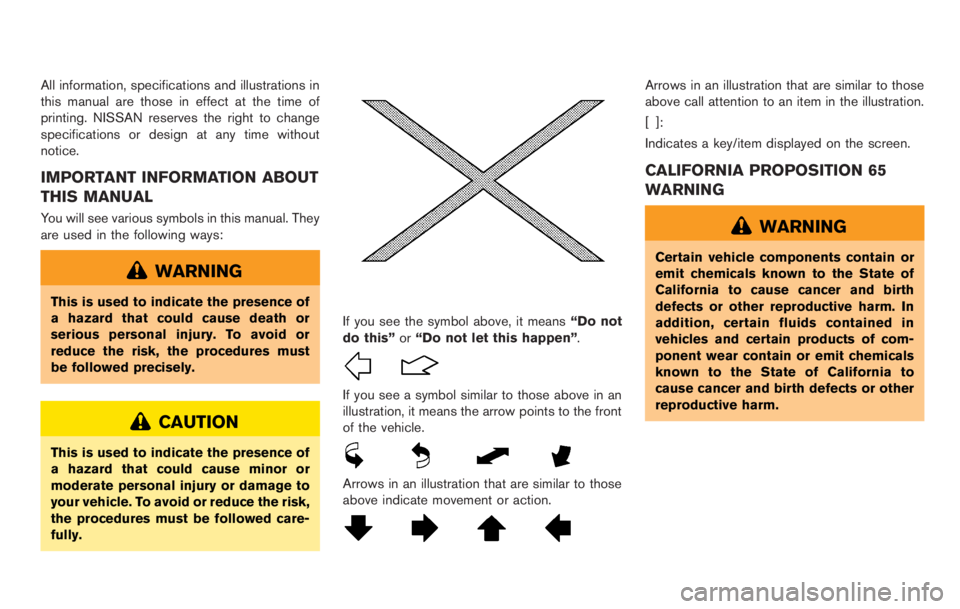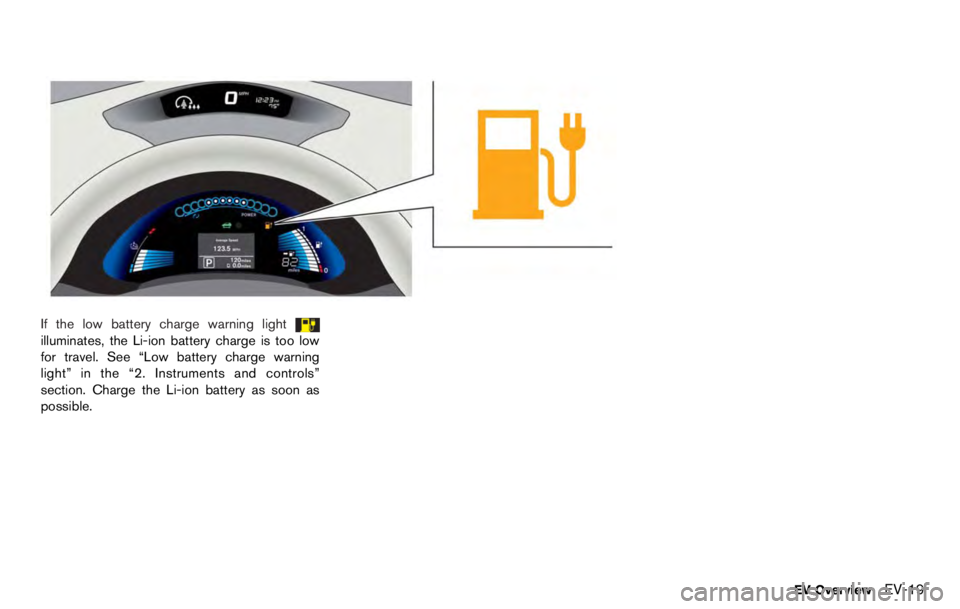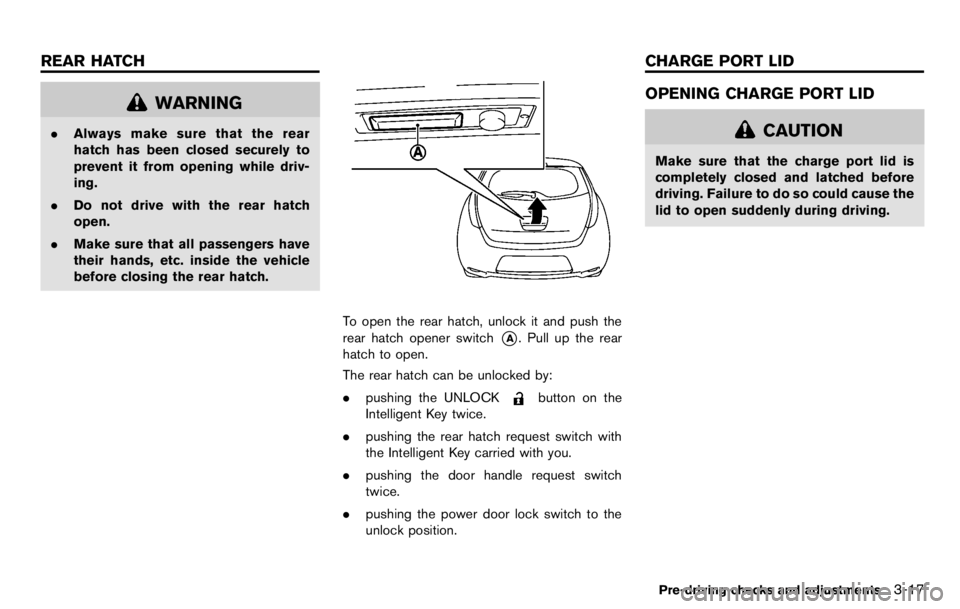reverse NISSAN LEAF 2012 Owners Manual
[x] Cancel search | Manufacturer: NISSAN, Model Year: 2012, Model line: LEAF, Model: NISSAN LEAF 2012Pages: 1062, PDF Size: 3.63 MB
Page 8 of 1062

.Never tow a vehicle using the vehi-
cle tie down hook or recovery hook.
. Always pull the cable straight out
from the front of the vehicle. Never
pull on the vehicle at an angle.
. Pulling devices should be routed so
they do not touch any part of the
suspension, steering, brake or cool-
ing systems.
. Pulling devices such as ropes or
canvas straps are not recommended
for use in vehicle towing or recov-
ery.
Rocking a stuck vehicle
If the vehicle is stuck in sand, snow, mud, etc.,
try to free it by following the procedure below.
1. Turn off the Vehicle Dynamic Control (VDC)
system.
2. Make sure the area in front and behind the vehicle is clear of obstructions.
3. Turn the steering wheel left and right to clear an area around the front tires.
4. Slowly rock the vehicle forward and back- ward.
.Shift back and forth between the R
(Reverse) and D (Drive) positions.
.Apply the accelerator as little as possible
to maintain the rocking motion.
.Release the accelerator pedal before
shifting between R and D.
.Do not spin the tires above 35 MPH (55
km/h).
5. If the vehicle cannot be freed after a few tries, contact a professional towing service
to remove the vehicle.
Page 9 of 1062

If the electric parking brake cannot be released
by operating the electric parking brake switch,
the parking brake can be mechanically released.
Note that the following procedure must be
performed only when the parking brake needs
to be released in an emergency.
NOTE:
.Depending on the type of parking
brake system malfunction, the parking
brake switch operation indicator may
blink and the electric shift control
system warning light may illuminate in
the meter.
. If the electric shift control system
warning light illuminates in the meter,
stop the vehicle in a safe location and
contact a NISSAN certified LEAF dealer
immediately.
. The mechanical release of the parking
brake should only be done if there is a
malfunction of the electric parking
brake system. After the parking brake
mechanical release has been done, the
vehicle needs to be repaired. Have your
vehicle inspected by a NISSAN certified
LEAF dealer.
To release the parking brake mechanically,
perform the following procedure. 1. Confirm that the vehicle is in the P (Park)
position. If the vehicle cannot be placed in
the P (Park) position, contact a NISSAN
certified LEAF dealer.
2. Check that the parking brake switch opera- tion indicator does not illuminate.
3. Place power switch in the OFF position.
4. Open the rear hatch.
5. Remove the tool for mechanical release from the tool set that is located in the cargo area.
6. Remove the luggage floor board from the cargo area.
7. Remove the cap by turning counterclock- wise.
8. Insert the tool and turn it counterclockwise while pushing it in.
9. Continue to turn it until it stops and then release your hand. The tool will then return
approximately the same position it was in
before it was turned and release of the
parking brake will be completed. Do not turn
the tool beyond the point at which it stops.
Doing so may result in damage.
10. Store the tool for mechanical release by performing the procedure for removing it in
reverse.
Page 42 of 1062

the power switch is placed in the OFF position
then back to the ON position.
The computer has a built-in diagnostic feature
that tests the system each time you start the EV
(Electric Vehicle) and move the vehicle forward
or in reverse at a slow speed. When the self-test
occurs, you may hear a “clunk” noise and/or feel
a pulsation in the brake pedal. This is normal and
is not an indication of a malfunction.
Page 216 of 1062

The sound stops when the vehicle stops.
The sound does not stop with the vehicle in the
R (Reverse) position even if the vehicle stops.
WARNING
.If the sound cannot be heard, pe-
destrians may not notice the on-
coming vehicle, which may cause an
accident resulting in serious injury
or death. Immediately contact a
NISSAN certified LEAF for VSP
system inspection.
. If the VSP system warning light
illuminates while the power switch
is in the ON position, or in the
READY to drive position, it may
indicate the VSP system is not
functioning properly. Have the sys-
tem checked by a NISSAN certified
LEAF dealer. See “Approaching Ve-
hicle Sound for Pedestrians (VSP)
system warning light” in the “2.
Instruments and controls” section.
Page 395 of 1062

the power switch is placed in the OFF position
then back to the ON position.
The computer has a built-in diagnostic feature
that tests the system each time you start the EV
(Electric Vehicle) and move the vehicle forward
or in reverse at a slow speed. When the self-test
occurs, you may hear a “clunk” noise and/or feel
a pulsation in the brake pedal. This is normal and
is not an indication of a malfunction.
Page 414 of 1062

.Never tow a vehicle using the vehi-
cle tie down hook or recovery hook.
. Always pull the cable straight out
from the front of the vehicle. Never
pull on the vehicle at an angle.
. Pulling devices should be routed so
they do not touch any part of the
suspension, steering, brake or cool-
ing systems.
. Pulling devices such as ropes or
canvas straps are not recommended
for use in vehicle towing or recov-
ery.
Rocking a stuck vehicle
If the vehicle is stuck in sand, snow, mud, etc.,
try to free it by following the procedure below.
1. Turn off the Vehicle Dynamic Control (VDC)
system.
2. Make sure the area in front and behind the vehicle is clear of obstructions.
3. Turn the steering wheel left and right to clear an area around the front tires.
4. Slowly rock the vehicle forward and back- ward.
.Shift back and forth between the R
(Reverse) and D (Drive) positions.
.Apply the accelerator as little as possible
to maintain the rocking motion.
.Release the accelerator pedal before
shifting between R and D.
.Do not spin the tires above 35 MPH (55
km/h).
5. If the vehicle cannot be freed after a few tries, contact a professional towing service
to remove the vehicle.
Page 415 of 1062

If the electric parking brake cannot be released
by operating the electric parking brake switch,
the parking brake can be mechanically released.
Note that the following procedure must be
performed only when the parking brake needs
to be released in an emergency.
NOTE:
.Depending on the type of parking
brake system malfunction, the parking
brake switch operation indicator may
blink and the electric shift control
system warning light may illuminate in
the meter.
. If the electric shift control system
warning light illuminates in the meter,
stop the vehicle in a safe location and
contact a NISSAN certified LEAF dealer
immediately.
. The mechanical release of the parking
brake should only be done if there is a
malfunction of the electric parking
brake system. After the parking brake
mechanical release has been done, the
vehicle needs to be repaired. Have your
vehicle inspected by a NISSAN certified
LEAF dealer.
To release the parking brake mechanically,
perform the following procedure. 1. Confirm that the vehicle is in the P (Park)
position. If the vehicle cannot be placed in
the P (Park) position, contact a NISSAN
certified LEAF dealer.
2. Check that the parking brake switch opera- tion indicator does not illuminate.
3. Place power switch in the OFF position.
4. Open the rear hatch.
5. Remove the tool for mechanical release from the tool set that is located in the cargo area.
6. Remove the luggage floor board from the cargo area.
7. Remove the cap by turning counterclock- wise.
8. Insert the tool and turn it counterclockwise while pushing it in.
9. Continue to turn it until it stops and then release your hand. The tool will then return
approximately the same position it was in
before it was turned and release of the
parking brake will be completed. Do not turn
the tool beyond the point at which it stops.
Doing so may result in damage.
10. Store the tool for mechanical release by performing the procedure for removing it in
reverse.
Page 457 of 1062

EMERGENCY SHUT-OFF SYSTEM
The emergency shut-off system is activated and
the high-voltage system automatically turns off in
the following conditions:
- Front and side collisions in which the air bags
are deployed.
- Certain rear collisions.
- Certain EV (Electric Vehicle) system malfunc-
tions
For the above collisions and certain other EV
(Electric Vehicle) system malfunctions, the
READY to drive indicator light will turn off. See
“Warning/indicator lights and audible remin-
ders” in the “2. Instruments and controls”
section.
The emergency shut-off activates for the above
collisions to minimize risk of an event that could
cause injury or an accident. If the emergency
shut-off system activates, the EV system may
not be switched to READY to drive position,
contact a NISSAN certified LEAF dealer. Even if
the power switch is switched to READY to drive
position, the system may shut-off suddenly.
Therefore, drive cautiously to the nearest
NISSAN certified LEAF dealer or contact a
NISSAN certified LEAF dealer as soon as
possible.WARNING
.Pay special attention to pedes-
trians. Because there is no engine
noise, pedestrians may not know
the vehicle is approaching, moving
or about to move, and may step into
the path of vehicle travel.
. When leaving the vehicle, be sure to
turn off the EV (Electric Vehicle)
system.
. Be sure to push the P (Park) posi-
tion switch on the selector lever and
apply the parking brake when park-
ing because the vehicle can move
when the READY to drive indicator
light is ON. When the READY to
drive indicator light is ON, do not
leave your vehicle in a shift position
other than the P (Park) position.
. Keep the brake pedal depressed
until you are ready to drive. When
the vehicle is in the D (drive) posi-
tion or ECO or R (reverse) position,
if you release the brake pedal and
do not depress accelerator, the
vehicle will creep and may start
abruptly. This may cause serious injury or death.
NOTE:
. The vehicle cannot run with a dis-
charged Li-ion battery. Repeated accel-
eration consumes more power from the
Li-ion battery than driving at a steady
speed.
. This vehicle is equipped with a regen-
erative brake system. The primary pur-
pose of regenerative brake system is to
provide some power to recharge the Li-
ion battery and extend driving range. A
secondary benefit is “engine braking”
that operates based on Li-ion battery
conditions.
. In the D (Drive) position, when the
accelerator pedal is released, the re-
generative brake system provides
some deceleration.
. When you put the shift selector in the
ECO position and take your foot off the
accelerator pedal, more regenerative
brake is applied than in the D (Drive)
position.
. Less deceleration is provided by the
regenerative brake system when the Li-
EV OverviewEV-9
EV (Electric Vehicle)
CHARACTERISTICS
Page 498 of 1062

EMERGENCY SHUT-OFF SYSTEM
The emergency shut-off system is activated and
the high-voltage system automatically turns off in
the following conditions:
- Front and side collisions in which the air bags
are deployed.
- Certain rear collisions.
- Certain EV (Electric Vehicle) system malfunc-
tions
For the above collisions and certain other EV
(Electric Vehicle) system malfunctions, the
READY to drive indicator light will turn off. See
“Warning/indicator lights and audible remin-
ders” in the “2. Instruments and controls”
section.
The emergency shut-off activates for the above
collisions to minimize risk of an event that could
cause injury or an accident. If the emergency
shut-off system activates, the EV system may
not be switched to READY to drive position,
contact a NISSAN certified LEAF dealer. Even if
the power switch is switched to READY to drive
position, the system may shut-off suddenly.
Therefore, drive cautiously to the nearest
NISSAN certified LEAF dealer or contact a
NISSAN certified LEAF dealer as soon as
possible.WARNING
.Pay special attention to pedes-
trians. Because there is no engine
noise, pedestrians may not know
the vehicle is approaching, moving
or about to move, and may step into
the path of vehicle travel.
. When leaving the vehicle, be sure to
turn off the EV (Electric Vehicle)
system.
. Be sure to push the P (Park) posi-
tion switch on the selector lever and
apply the parking brake when park-
ing because the vehicle can move
when the READY to drive indicator
light is ON. When the READY to
drive indicator light is ON, do not
leave your vehicle in a shift position
other than the P (Park) position.
. Keep the brake pedal depressed
until you are ready to drive. When
the vehicle is in the D (drive) posi-
tion or ECO or R (reverse) position,
if you release the brake pedal and
do not depress accelerator, the
vehicle will creep and may start
abruptly. This may cause serious injury or death.
NOTE:
. The vehicle cannot run with a dis-
charged Li-ion battery. Repeated accel-
eration consumes more power from the
Li-ion battery than driving at a steady
speed.
. This vehicle is equipped with a regen-
erative brake system. The primary pur-
pose of regenerative brake system is to
provide some power to recharge the Li-
ion battery and extend driving range. A
secondary benefit is “engine braking”
that operates based on Li-ion battery
conditions.
. In the D (Drive) position, when the
accelerator pedal is released, the re-
generative brake system provides
some deceleration.
. When you put the shift selector in the
ECO position and take your foot off the
accelerator pedal, more regenerative
brake is applied than in the D (Drive)
position.
. Less deceleration is provided by the
regenerative brake system when the Li-
EV OverviewEV-9
EV (Electric Vehicle)
CHARACTERISTICS
Page 517 of 1062

The sound stops when the vehicle stops.
The sound does not stop with the vehicle in the
R (Reverse) position even if the vehicle stops.
WARNING
.If the sound cannot be heard, pe-
destrians may not notice the on-
coming vehicle, which may cause an
accident resulting in serious injury
or death. Immediately contact a
NISSAN certified LEAF for VSP
system inspection.
. If the VSP system warning light
illuminates while the power switch
is in the ON position, or in the
READY to drive position, it may
indicate the VSP system is not
functioning properly. Have the sys-
tem checked by a NISSAN certified
LEAF dealer. See “Approaching Ve-
hicle Sound for Pedestrians (VSP)
system warning light” in the “2.
Instruments and controls” section.